This recipe for homemade cinnamon rolls produces perfect pillowy soft cinnamon buns consistently. This recipe has a rise time of 2 hours and a total of 4 foldings (video guidance below!). Allowing the dough to rest overnight in the fridge yields the best results and makes this recipe convenient for a morning bake! These cinnamon rolls are 100% worth the effort. The cinnamon rolls will emerge from the oven gooey, pillowy soft and perfect.
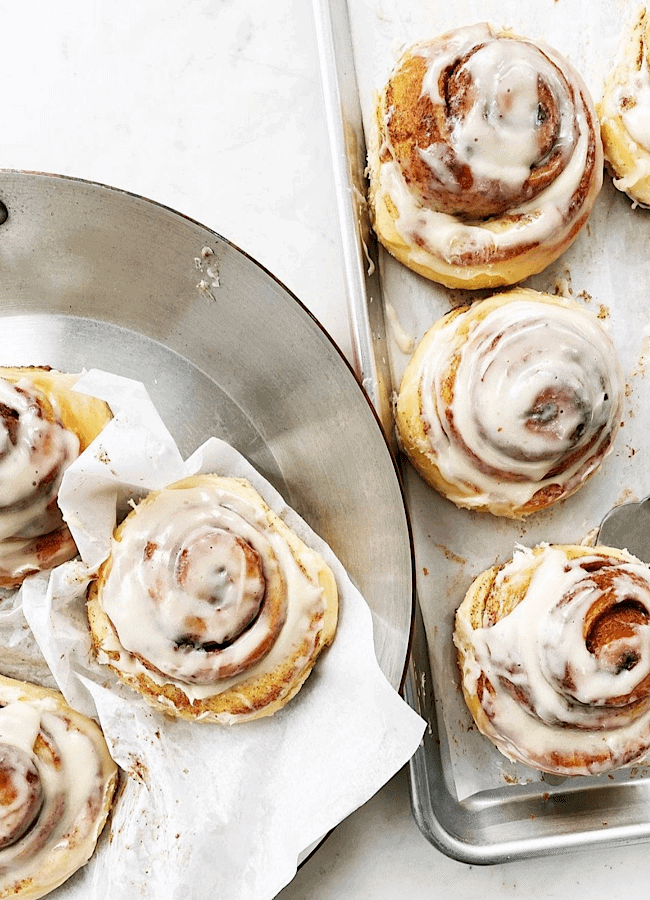
I like my cinnamon rolls super soft and gooey, so I put a thin layer of the icing over them while they are still warm. The icing melts into the just baked rolls, eliminating any hard corners or edges.
If you prefer a little crispy crunch to your cinnamon rolls, you can wait until they have cooled and then top them with all the icing. Or you could make this cinnamon buns recipe that has a cinnamon sugar dusting instead of icing!
And I now have a MINI CINNAMON ROLL recipe that makes 36 perfect little buns, generously finished with cream cheese icing! They are soft and gooey just like these.
Tips for Making the Best Cinnamon Rolls:
1. What if I don’t have instant yeast? You can still use active yeast. Active dry yeast is a little different than instant in that it used to be made with larger granules and needed to be dissolved first. However, most yeast made today has similar sized granulates, so you can skip this step.
It should be fine to use the active yeast in the recipe as written. If you are worried about it, you could dissolve the yeast in the warm milk instead of adding it to the flour mixture. Red Star Yeast has a great FAQ page troubleshooting yeast here. You can read more about the difference in yeast here.
2. Is the dough supposed to be this sticky after mixing? YES! It is. The directions call for it to be chilled after mixing, which will help with the rolling out process. If you don’t chill the dough, it will be hard to roll out.
3. What if I don’t have all-purpose flour? Bread flour is a fine substitution, but the texture will be slightly different, and not as fluffy.
*Caution, whole wheat flour will make the rolls more dense, and you may need to add more liquid to the dough.
4. Can I add more cinnamon flavor? Of course! I sometimes use 3/4 cup brown sugar and 4 teaspoons cinnamon for the filling.
5. Can I shape the buns and let them rise overnight in the fridge? Yes! There are directions below on how to do so (this step still requires that the dough be chilled first before rolling).
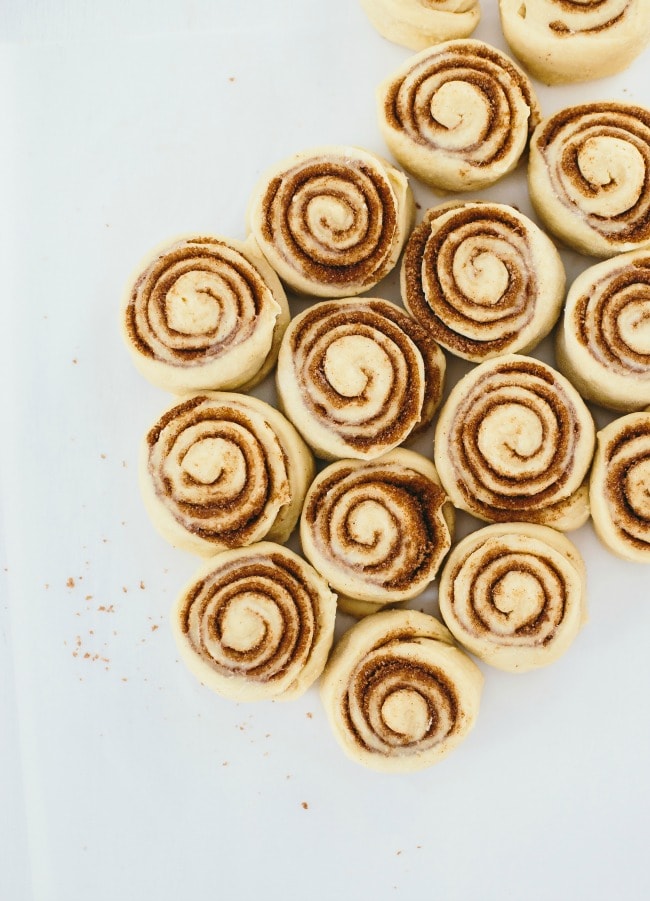
6. Can I freeze the baked buns?
If you want to bake the buns and freeze them, you can. Once cooled, wrap them in plastic, and then place them in a freezer bag for up to 2 weeks.
When ready to eat, thaw, warm, and then coat with icing. They may not be as soft and tender as fresh-baked buns.
7. Can I substitute something else for the honey? I honestly haven’t tried it, and the ratios may have to be adjusted somewhat when changing out sugar-y liquids. Or try maple syrup instead. Here’s how to substitute other liquids.
8. Can I use other egg sizes beside large? Yes. Check out this egg size conversion chart for replacing egg sizes.
9. Why do I knead the dough straight from the fridge and then let it rest again? Kneading the dough a few times (10 to 12, as indicated in the recipe) helps wake the gluten up.
There is a lot of butter in this dough which can get in the way, so sometimes it needs a little help. Then covering it and letting it rest for 20 minutes before rolling it will help the gluten relax so it is easier to roll.
My Cinnamon Rolls recipe was featured on The Kitchn, and the Pancake Princess declared it the winner of her Cinnamon Roll Bake Off! I created this recipe for my first cookbook, The Vanilla Bean Baking Book. In my 4th cookbook, 100 Morning Treats, I published a new recipe; Soft Buttermilk Cinnamon Rolls with Cream Cheese Icing.
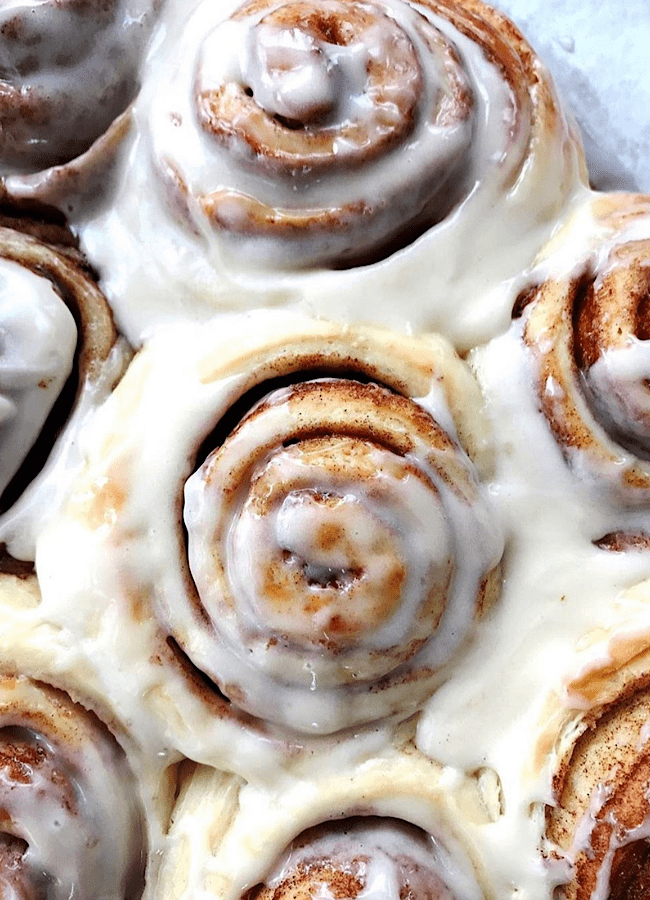
How to Fold Cinnamon Roll Dough
I’ve included a video below of the folding process, which shows how to do it. This little extra step is the secret to the pillowy soft texture of the rolls!
Why do I fold the dough? Folding the dough helps improve the dough’s structure, ensures gluten will form, and makes it easier to handle.
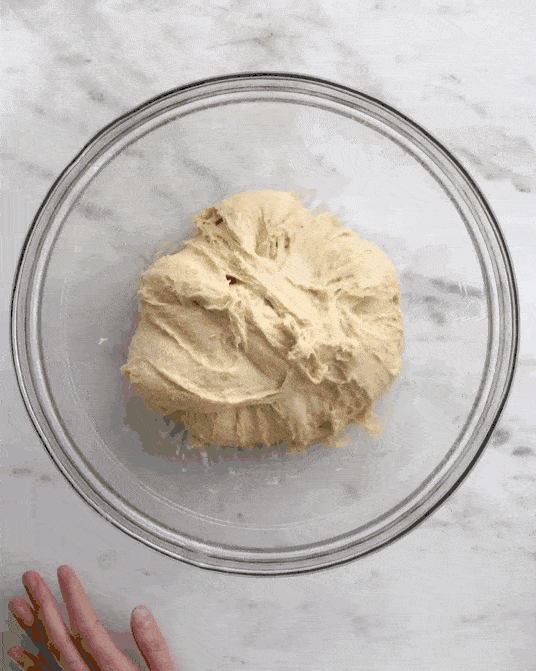
More Cinnamon Roll Recipes:
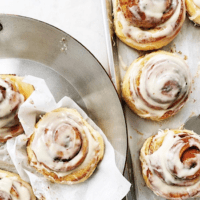
Soft and Gooey Cinnamon Rolls
Ingredients
Dough
- 4 large eggs, at room temperature
- 3/4 cup warm whole milk (100 to 110F [35 to 42C])
- 1/4 cup [85 g] honey
- 4 cups [568 g] all-purpose flour
- 2 1/4 teaspoons instant yeast
- 2 teaspoons salt
- 10 tablespoons [1 1/4 sticks or 142 g] unsalted butter, at room temperature, cut into 1 in [2.5 cm] pieces
Filling
- 1/2 cup [100 g] packed brown sugar
- 1 tablespoon ground cinnamon
- Pinch salt
- 2 tablespoons [29 g] unsalted butter, melted and cooled
Frosting
- 8 tablespoons [1 stick or 113 g] unsalted butter, room temperature
- 4 ounces [114 g] cream cheese, room temperature
- 1 teaspoon pure vanilla extract
- 1/4 teaspoon salt
- 1 cup [120 g] confectioners' sugar
Equipment
- 9 by 13 in [23 by 33 cm] Baking Pan
Instructions
For the dough
- Grease a large bowl.
- In a large liquid measuring cup, combine the eggs, milk, and honey.
- In the bowl of a stand mixer fitted with a paddle, mix the flour, yeast, and salt and stir on low to combine. Add the egg mixture and mix on low to combine. With the mixer on low, add the butter, one piece at a time. When all the butter has been added, increase the speed to medium and beat the butter into the dough, until all the little butter pieces are incorporated, 1 minute. Transfer the dough to the prepared bowl. The dough will be very sticky and you will need a spatula to scrape the dough into the bowl.
- Cover the bowl with plastic wrap and let rise for 30 minutes. Place your fingers or a spatula underneath the dough and gently pull the dough up and fold it back over itself. Turn the bowl and repeat this folding again. Continue 6 to 8 more times, until all the dough has been folded over on itself. Re-cover the bowl with plastic and let rise for 30 minutes. Repeat this series of folding 3 more times, for a rise time of 2 hours and a total of 4 foldings (see the GIF above on how to do this folding). Tightly cover the bowl with plastic wrap and refrigerate overnight or up to 72 hours.
To Assemble
- Flour a work surface and knead the cold Sweet Dough 10 to 12 times (see troubleshooting above for why). Shape the dough into a ball, cover the top lightly with flour, and cover with a tea towel and let come to room temperature.
- Grease a 9 by 13 in [23 by 33 cm] pan; if desired, line with parchment paper (this makes for easier cleanup).
- In a small bowl, mix the brown sugar, cinnamon, and salt.
- Roll the dough into a 16 by 12 in [30.5 by 40.5 cm] rectangle. Brush the dough with the melted butter and sprinkle the cinnamon-sugar mixture evenly over the top, pressing it lightly into the butter so it adheres. Starting at a long side, roll the dough into a tight cylinder. Pinch the seam gently to seal it and position the dough seam side down. Use scissors or a sharp knife to cut the dough into 12 equal pieces. Transfer the pieces to the prepared pan and place them cut side up. Cover the pan loosely with plastic wrap and let the dough rise until doubled, 1 to 1 1/2 hours.
- Adjust an oven rack to the middle position. Preheat the oven to 350F [180C]. Remove the plastic and bake 27 to 32 minutes, rotating the pan halfway through, until the rolls are golden brown. While the rolls are baking, prepare the icing.
- Transfer the pan to a wire rack and let cool for 5 minutes. Using an offset spatula or table knife, apply a thin layer of the cream cheese icing, using about one-third of the mixture. Let the rolls cool for another 15 to 20 minutes. Top with the rest of the icing and serve.
For the icing
- In the bowl of a stand mixer fitted with a paddle, beat the butter and cream cheese on medium until smooth and creamy. Add the vanilla and salt and mix on low to combine. Add the confectioners' sugar and mix on low until combined. Scrape down the sides of the bowl and mix on medium until the icing is light and fluffy, 3 to 4 minutes.
**For overnight cinnamon rolls
- Prepare the rolls (roll out dough, fill them, roll them up, cut them, and put them in the prepared pan, but do not let rise for 1 1/2 hours as stated above) then cover them loosely with plastic and refrigerate for up to 18 hours. When ready to bake, preheat the oven, and let the rolls sit at room temperature (still covered in plastic) for 30-45 minutes. Bake as directed (they make take slightly longer to bake).

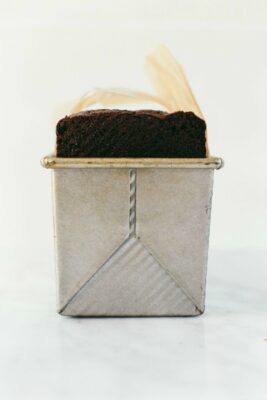
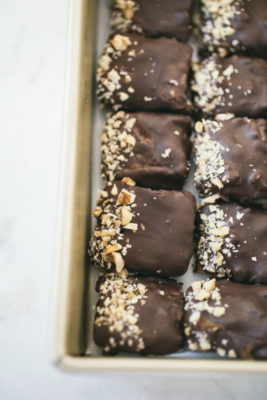
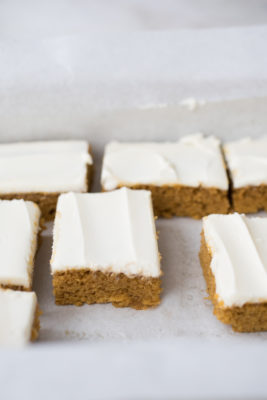
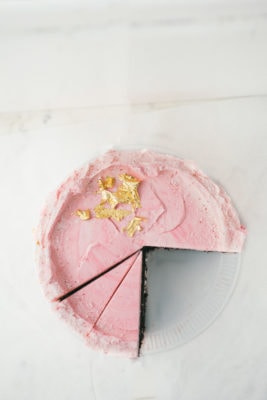
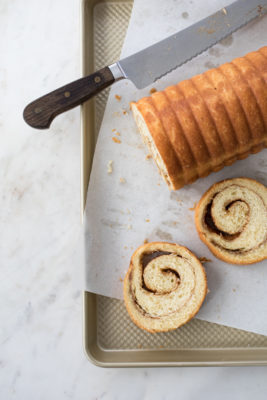
517 Comments
Mara
Tuesday, December 9, 2025 at 1:34 pmBest cinnamon rolls I have ever had
Jenny
Monday, December 1, 2025 at 5:50 pmBest cinnamon rolls recipe! On my second attempt, I did skip the overnight sweet dough step (kept dough in fridge for 3 hours) and the rolls came out like Hawaiian bread (pillowy but not the not the same) so please do not skip overnight step!
Susan Lipscomb
Monday, November 24, 2025 at 8:45 amI can’t find the video instructions on how to fold the dough. Could you explain exactly where it is?
ACN
Saturday, November 22, 2025 at 10:25 amHi Sarah- I make this recipe every year for Christmas morning which is the highlight for my kiddos. Thank you!
This year I have to have a double mastectomy on Dec 22. Womp womp. Thanks a lot, cancer.
Do you think I could make them and freeze them UNBAKED?
Would you move them to fridge the night before and then bake Christmas morning?
Thanks!
Sarah Kieffer
Monday, December 8, 2025 at 11:11 amYou can – just note that the longer the yeast is in the freezer, the less effective it is. I find they don’t rise quite as well baked from frozen, but they still are good! And, sending love and light to you xx
Marie Pier Pitre D'Iorio
Saturday, September 27, 2025 at 2:40 pmBest cinnamon rolls recipe !
Jamie
Saturday, September 27, 2025 at 12:17 pmThe part about refrigeration is quite confusing. So i’m not even for sure if i’m doing it right! But I hooenso because they look amazing in here. I’m assuming after we do all the folding it, goes in the refrigerator overnight and then we make the cinnamon rolls and they go in for another night? Or they just go in there one night. Roll it out, Make the buns, and bake the next day? Definitely needs more clarification.
Samantha
Wednesday, September 24, 2025 at 7:55 pmAmazing recipe! Could you further clarify the overnight instructions? After taking the dough out of the refrigerator, do you knead the cold dough, let it come to room temperature, fill, roll and refrigerate again? Or do you leave out the let it come to room temperature part?
Ali
Sunday, October 19, 2025 at 9:00 amYou take the dough out after letting it proof in the refrigerator overnight or up to 72 hours. After taking the proofed dough out knead while it is cold then let reach room temp, then roll out dough, sprinkle filling, form cinnamon rolls, cut and let rise for 1-1.5 hours then bake. Only need to be refrigerated once.
Juliana
Friday, September 5, 2025 at 9:07 pmLove this recipe! Softest rolls ever! I was scared because the dough was a bit wet, but they turned out flakey and moist.
Tracey B
Tuesday, September 2, 2025 at 8:47 pmThis is a fabulous recipe I have made it on several occasions. Tonight I got distracted and forgot to add in the butter realized after I put the dough in the grease bowl ,so I dumped the dough quickly back in the standup mixer bowl and tried to mix it , it looked odd but I carried on and dumped it back in the greased bowl to start the 2 hour proofing . My question is will it turn out or should I start over ? Thanks
Jen
Thursday, August 21, 2025 at 8:02 amSuper easy! I did two overnight rests. The first time, I let the dough rest in the fridge on Sunday. On Tuesday night, I took it out, filled, rolled, and shaped it in a pan. Then it went back in the fridge for the second overnight rest. On Wednesday night, I took them out while the oven preheated, baked for 25 minutes, and they were ready. Recipe could’ve been done by monday night but was too lazy to bake. Great for lazy bakers 🙂
Jaclyn
Saturday, July 12, 2025 at 6:27 pmThese didn’t work out for me. The only change I made was to use Gold Medal flour. The dough was nonsensically wet. I had to flap it about with my bench scraper. I wet my hands to handle it at all. Maybe that ruined them. They puffed up but remained somehow dense and filled with pockets like cake. I thought overcooked them maybe so I dropped the temp 50 degs for a second batch. No better. After 3 days making them I threw them away. Maybe I will try again.
Manon
Monday, December 1, 2025 at 10:19 amI experienced the same. The dough was way too wet to be handled, and each fold resulted in a mess. I am not a fan of the rolls, thought the dough was on the dry side and the rolls didn’t have a lot of cinnamon flavor. I work with yeast all the time and am an experienced baker. This recipe was way too much work for the outcome in my opinion.
Wendy
Saturday, July 12, 2025 at 7:10 amcan I freeze the dough for a week, then thaw it over night in the fridge, maybe need it a few times to wake it up, then roll the dough and bake???
Mehar-un-Nisa
Thursday, July 3, 2025 at 3:14 pmHi there.
The part about refrigeration is a bit confusing. You first say refrigerate it for upto 72 hours after the 4 folds and then at the end you have **when refrigerating overnight which basically says complete the whole process up until cutting the dough and putting it in the pan and then refrigerating. So in this case, after the four folds I can proceed to rolling out the dough and shaping the buns etc? And once they are in the pan only then refrigerate them?
Emmy
Sunday, June 29, 2025 at 12:39 pmThis recipe has rave reviews and I’m sure it’s absolutely fantastic when done right. However, I don’t have a stand mixer and mixed it all by hand. I don’t know what else I did wrong because I measured everything perfectly, didn’t use any substitutes and was super methodical with following the recipe exactly. My dough came out extremely wet, sticky, and so hard to work with that I literally almost started crying. It was closer to a batter than a dough, and all of the rolls just melded together into one large rectangle during baking. The end result was honestly sort of funny because I’m sure I messed up somewhere – however, please please mention in your recipe that using a stand mixer is an essential part of this recipe.
Sarah Kieffer
Friday, July 11, 2025 at 3:02 pmThe dough is supposed to be sticky, and refrigerated overnight. If your kitchen is extra hot (which happens in the summer months), that can also cause the dough to be extra sticky, and the the butter in the dough to melt more. I’m so sorry you had trouble!
Vickie
Friday, December 12, 2025 at 11:03 amEmmy, you do not need a stand mixer to make this recipe. I use a whisk and spatula for the dough part of the recipe. I melt the butter and whisk everything together except for the yeast and flour. Depending on whether it’s summer or winter and if I don’t have the time to let the eggs come to room temperature, I’ll also heat the milk. I want the mixture temperature to be around 75F. Then I add the yeast and whisk together. I then add the flour and mix together with the spatula. It’ll be shaggy at first and then more like a batter when all of the flour is mixed in and hydrated. Perform the folds (I use the spatula) and then leave in fridge. During the summer I put the batter/dough in the fridge between folds. It’ll still be sticky and batter like after the folds. Only after the 12-24 hour rest in fridge will it be like a dough instead of a batter. I actually like to keep it in the fridge for 72 hours with a round of folds every 24 hours to punch it down.
Hope you’ll try this recipe again and my steps help. Everyone I serve them to loves these cinnamon rolls.
Emmy
Friday, June 20, 2025 at 9:02 amI don’t have a stand mixer, I only have a hand mixer with two whisk attachments. Is it better for my to just mix by hand using a rubber spatula (or something else)?
Pam
Saturday, June 7, 2025 at 2:00 pmYour recipe calls for 4 cups (568gr.) flour
I’ve always weigh my ingredients and a cup of
Flour weighs 120g so that would be a total of 480g.
Should I use 480g or 568g ?
Thanks
Sarah Kieffer
Saturday, June 7, 2025 at 2:14 pmThroughout my recipes posted on this website, 1 cup of flour equals 142g. Please note that 1 cup of flour can range anywhere from 120g to 142g, depending on the baker or website. I found that after weighting many cups of flour and averaging the total, mine always ended up around this number. If I am posting a recipe from another cookbook, I will use whatever gram measure of flour used in that book, which is why you may see a few posts with a different cup measurement.
Olivia
Monday, April 7, 2025 at 3:42 pmThink they’re just referring to the initial steps where you used a mixer for the ingredients — i have the same question! Can we just mix in the butter, flour, etc with a wooden spoon for example? Or will it just be a sticky mess? x
Emily H
Monday, March 31, 2025 at 8:49 amSensational recipe!!! Takes some time but not much is hands on and it’s so worth it! I do double the filling and frosting because is our preference. The texture of these is so soft and perfect!!
Sara
Saturday, March 22, 2025 at 10:35 amLove these cinnamon rolls and am making them for an upcoming morning wedding. I need to make about 80 of them and would be SO grateful to know of is possible to freeze the dough after filling and rolling and how you would go about thawing and baking them. Wedding is in 2 weeks so I thought about making the dough next weekend so I wasn’t having to scramble.
Paula
Friday, February 14, 2025 at 11:56 amI have made this recipe multiple times and this is hands-down my favorite cinnamon roll recipe. My husband loves cinnamon rolls and these are his absolute favorite too. Yes, it takes a long time to prep but it’s SO worth it. I do think that refrigerating the dough overnight lends to a deeper flavor and a better texture than a typical cinnamon roll. They’re soft and pillowy, and not too sweet. 10/10!!
Vanessa
Sunday, January 26, 2025 at 5:42 pmIn the recipe instructions, we need to let the dough rest after kneading and shaping it into a ball until it comes to room temperature. In the question part about why we knead, you mention kneading and then letting it rest for 20 minutes. If it takes much longer for the dough to come to room temp, does that have an effect on the way the cinnamon rolls turn out? Or is it ok to roll it out after 20 minutes even if it is still pretty cold (like in the 50s°F)? It took an hour just to get my dough to warm up to 66°F, which is just under room temp. The dough was very soft when I was trying to roll it out and shaping it was difficult. Once I cut the rolls and placed them in the pan to rise, I was worried that having left the dough out so long to warm up and then doing a 1-1 1/2 hour rise would cause it to over proof. The cinnamon rolls rose a lot in the oven, turned out soft, and taste good, but I don’t know if they are exactly “pillowy”, seem a little denser. Do you have an image of a section through one of your cinnamon rolls you could share to get an idea of the interior texture?
Rp
Thursday, January 23, 2025 at 3:16 pmMy family asks for these constantly! I don’t make them that often because they do take some time. I half the frosting ingredients, double the filling and add vanilla to the milk mixture. They’re sooo good!!
Lizzy
Tuesday, January 14, 2025 at 7:05 pmThese are the best cinnamon rolls I’ve ever tasted. I’m not over exaggerating. Every bite was heaven, I ate these in pure silence with my girlfriend because they were too good to be distracted with talking.
Also, note for anyone making these by hand: it is possible to make the dough and knead by hand, it just takes a lot of elbow grease and the feeling of soft butter on your hands will be vaguely unpleasant. But it is well worth the effort!
Erin
Sunday, January 12, 2025 at 3:21 pmWhat happens if you don’t chill the dough overnight?
Danielle
Sunday, December 29, 2024 at 7:41 amThe first time I made these, they turned out EXCELLENT. After I chilled the dough overnight, it was perfectly workable. However, this time after I took the dough out of the fridge in the morning, it was still WAY too sticky! Do you have any advice for this?
Robbin
Saturday, December 28, 2024 at 1:39 pmI make cinnamon rolls every year, but this year I used your recipe and OH MY GOODNESS they were the best I have ever made! My entire family agreed that this is the recipe that will be used from now on. Unfortunately, I can’t eat them so the joy I get comes from that sound someone makes after their first bite ? I enjoyed them almost as much as they did!
BRENDA ANDERSON
Saturday, December 28, 2024 at 10:00 amThey are delicious BUT hard to work with. I chilled my dough thoroughly and it was still very sticky. I am an experienced baker and struggled to roll it up.
Madeleine
Thursday, December 26, 2024 at 2:22 pmI can’t believe more people aren’t mentioning how ridiculously LONG these take to make. Seriously the most time consuming cinnamon rolls I’ve made in my life. Was hoping for a blow-my-socks off taste sensation after my 48hrs of work was over .. unfortunately not.
The buns have a bready, close to a croissant, like texture and not enough filling. Very disappointed, should have stuck to my old tried and true vs trying something new and ‘fancy’ for Christmas.
Bubbie Gautschalk
Tuesday, March 11, 2025 at 1:01 amI’d suggest that you just buy the pre-made cinnamon rolls that come in the refrigerator section of your grocery store.
sophben
Wednesday, December 25, 2024 at 1:52 pmthe only cinnamon roll recipe I will ever be using again from now on.
Annie
Wednesday, December 25, 2024 at 12:21 pmMade these for Christmas brunch and they were delicious! Followed the recipe pretty closely, refrigerated the dough overnight and rolled out this morning. I didn’t have instant yeast, so used 1.25x what the recipe called for of active dry yeast, mixed that with the warm milk and a pinch of sugar and let it rest for a few minutes before adding it to the flour which seemed to work fine.
Next time I’d like to add more cinnamon and maybe a pinch of nutneg, but no other changes needed! I made 1.5x the frosting since we like the frosting on the thick side.
Amber
Wednesday, December 25, 2024 at 11:55 amThanks for sharing this recipe. I only have a 9×13 Glass baking dish, would this work? What is the best baking pan for cinnamon rolls, can you recommend either glass or metal? Thanks in advance
Sarah Kieffer
Thursday, December 26, 2024 at 9:47 amMetal is best – with glass pans the buns will cook faster on the edges and be overcooked by the time the middles are done.
Louann
Wednesday, December 25, 2024 at 11:08 amSimply…excellent!
Kesa Sovulewski
Monday, December 23, 2024 at 4:34 pmPerfection 🙂
Rina
Sunday, December 22, 2024 at 12:57 pmMany people have asked if they HAVE to be refrigerated overnight and have yet to get a response….sooo….do they HAVE to be refrigerated overnight?
Vickie
Friday, December 12, 2025 at 11:27 amThis is basically a no-knead recipe. If you don’t want to coldproof it overnight, you’ll need to knead it until it’s no longer sticky and then let it proof.
Dianna
Saturday, December 21, 2024 at 2:55 pmYes, ma’am! I’ve made a lot of cinnamon rolls in my 50 years and I learned from the very best (thanks, Grandma) when I was little. Her recipe has my heart, but these cinnamon rolls are my absolute go to. It’s the process— so perfectly suited to a busy schedule, so easy to perfectly time for breakfast, so consistent I don’t even have to pray to the baking gods (but, of course, I do anyway). A real gem of a recipe. Thanks for sharing it!
Ashley
Monday, December 9, 2024 at 2:00 pmThese were the fluffiest cinnamon rolls over ever made. For some reason they grew out in a swirl maybe I didn’t roll them tight enough or were over crowded not sure. Also it was extremely bready and lost the sugar cinnamon in the roll somewhere. I may double the filling next time.
Ali
Monday, November 18, 2024 at 5:38 pmThis is perfection! I have made many recipes and always struggle to get it fluffy and soft, but this was IT. Will not be using another recipe ever again. So stoked, thank you!
Ariana
Tuesday, November 12, 2024 at 1:48 amHow do we adjust recipe for high altitude?
ali
Tuesday, December 24, 2024 at 9:20 amI live at 9500 feet and didn’t adjust at all came out perfectly!
Jeannie Lingle
Thursday, November 7, 2024 at 6:23 amI’m obsessed with these cinnamon rolls and make them as my most popular item. However, in the mi the since I began using this recipe, I’m noticing that when the rolls cool, the layers are separating. I do t k ow what I’m doing wrong! I’m desperate to have the beautiful rolls I had when I first found this recipe!
Marinda
Monday, October 21, 2024 at 4:33 pmAMAZING!!! This is my first time making cinnamon rolls, the roll is pillowy and so delicious. My were not pretty but they were delicious. I can’t wait to make them again. I watched a few videos on YouTube for tips on how to roll out and cut cinnamon dough. They will be pretty next time. Thank you for sharing this recipe.
Lauren
Monday, October 14, 2024 at 10:34 pmIs it possible to make ahead and freeze this dough?
lindsay
Saturday, October 12, 2024 at 5:35 pmdo you have to refrigerate over night?
Nathalie
Monday, October 20, 2025 at 7:08 pmShe said put in fridge overnight in the directions. she also answered the same.question ealier
Emily
Sunday, October 6, 2024 at 6:09 pmI found these from Pancake Princess’ cinnamon roll bake off and wow – the best I’ve ever made and maybe the best I’ve ever eaten! I had to make a few changes to make them lower glycemic index – specifically whole wheat bread flour and coconut sugar for the filling and powdered swerve for the frosting but even with these changes they were phenomenal.
Jen
Wednesday, December 25, 2024 at 6:59 amCan you share your exact changes? This diabetic lover of sweets would love to try it!
Allie
Wednesday, September 25, 2024 at 9:06 pmCan’t use bread flour as a substitute for all-purpose flour?
Steph Turcotte
Monday, September 16, 2024 at 12:54 pmHello.. so I made this recipe- I’m on my last stretch and fold it’s been 2 hours I’ve done 4 folds within the past two hours. I want to bake them tonight, so do I put the bowl with the dough in the fridge? Then take them out tonight, roll, fill, cut and shape then let rise for 1 hour then bake? Or how do I do this? I’m a bit confused. I made them this afternoon around 12pm and it’s now 2pm – I want them for tonight.
Julia
Tuesday, September 3, 2024 at 2:07 pmI made these yesterday and they were out of this world right out of the oven, amazing reheated after dinner, and still just as delicious for breakfast this morning! Wondering if you’ve had success doubling this recipe to feed a crowd?
Mohammed
Friday, August 23, 2024 at 5:28 amTbe last time I tried store bought cinnamon rolls, they were so so sooo terrible. It was like they spilled a whole bottle of cinnamon-chemical-essense into it. Do you prefer using seylany cinnamon or cassia cinnamon btw?
Mona
Thursday, August 15, 2024 at 2:04 pmGreat rolls based on recommendation from Pancake Princess and the Kitchn, however, my rolls were thicker and not as many swirls like in your picture. I wonder if I should have rolled it and put the cinnamon after kneading it AND then let it rise for double the time?
Kelley
Wednesday, July 3, 2024 at 8:42 pmWow! This is my go-to recipe! I have printed this out and use it EVERY time I make cinnamon rolls and orange rolls!
Michael B
Thursday, June 27, 2024 at 10:50 amThank you for this technique! The results are perfect. Any other recipes which use this dough?
emma
Sunday, June 9, 2024 at 9:32 amWhat should I do if my dough is not really sticky?
Lotta
Sunday, June 2, 2024 at 4:51 amWill these work if we can’t refrigerate them overnight? What is the minimum amount of time they should be in the fridge for the dough to still be easy to work with?
amber
Sunday, April 7, 2024 at 2:17 pmI did the initial mix in my food processor and it worked great, I don’t have a stand mixer either.
Caroline
Sunday, March 31, 2024 at 8:02 amHands down the best cinnamon rolls I’ve ever made! Worth the patience for all the rises. Put them in the fridge overnight after rolling them up and they turned out so so great. Will be making again and again!!!
Claudia
Friday, March 29, 2024 at 4:13 amEverytime I forget that this I not a whisk and set recipe, so I start a little late. I’ve tested a lot of recipes and this is one of my favourites. It is the most bready roll that I’ve tried so far. It doesn’t have too much sugar and especially the icing is my favorite for the reason that it has a little tang.
Ceren Ke
Sunday, March 24, 2024 at 11:43 amHi there, I’m working on making your cinnamon rolls.
The dough has tiny beads of instant yeast. I think it would be better to mix the yeast in with the egg mixture. Warm milk and sugar from honey will help activate and melt the beads. Then adding this into dough.
Thank you.
Sandra
Friday, March 8, 2024 at 10:56 amCan you double the recipe?
Teresa
Sunday, March 3, 2024 at 10:33 pmThis has been my favorite unbeatable cinnamon roll recipe for years. My son is allergic to eggs, so I made an experimental half batch using Bob’s Red Mill egg replacer. I was nervous because the dough was not sticky as usual after mixing. I added a tiny bit more water (the egg replacer calls for water, not the standard recipe), and the texture felt a bit better. The dough was dense and much less pliable than normal when working with it, but FEAR NOT! The end result after baking was perfect!! The texture was soft and gooey as usual. Highly recommend if you need an egg-free version!
Janet D
Wednesday, February 21, 2024 at 12:19 pmCan the dough ever be too sticky. Mine is sticker than the dough in the video showing how to fold the dough.
TIA
Sarah Kieffer
Friday, April 26, 2024 at 8:42 amHi Janet – Did you chill the dough? If your kitchen is running hot and the dough is warming up and sticking, you can put it back in the refrigerator for a few minutes and try again.
Lisa
Wednesday, February 21, 2024 at 11:01 amThese are amazing! I was wondering if it is possible to freeze the unbaked rolls so that I have a ready supply on hand for family. If yes, what would be your recommended steps? Would you make the log and freeze the uncut log? Then take it out, thaw, cut, and let rise the 1.5 hours before baking? Or would you cut them, freeze them, then thaw and do the rise (this of course would take much longer than the 1.5 hours), and then bake?
Thank you so much. I am eager to try your pan banging cookies next!
Aziz
Saturday, February 10, 2024 at 4:28 pmCan this recipe be adapted for sourdough cinnamon rolls?
britania
Tuesday, February 6, 2024 at 2:10 pmWow best cinnamon roll dough recipe I’ve tried! I did have some complications that I was hoping to get your advice on.
The factors that may have contributed to my issues are that I was in the mountains (Big Bear Lake) and I let the last 90 minute ride go too long (more like 3 hours).
My biggest issue was that the tops were very brown to the point that I didn’t want them to get any browner and the bottoms were still raw dough. Was this due to the long last rise/elevation or if not, is there something I can do to prevent this?
The other question was about rolling it out. My dough was pretty tough and didn’t want to stretch with a rolling pin. It did a bit but soon got to a point where any stretching immediately shrunk. I ended up needing to use my hands but this made it difficult to make the dough a uniform thickness and some spots were too thin. How can I make the rolling easier on my next batch?
Thanks for your advice and the AMAZING recipe!
Brian
Saturday, February 3, 2024 at 11:06 amI don’t generally comment on recipes but I just want to say thanks for sharing this. It’s by far the best cinnamon roll recipe I’ve ever tried. I like a generous amount of icing so I’ll probably double that next time. Haha Thanks!
Ashley
Friday, February 2, 2024 at 1:34 pmThis is my favorite cinnamon roll recipe ever! Winners every time.
I have a friend who is celiac…wondering if anyone has attempted to make with 1:1 gluten free flour?
Alison
Saturday, January 27, 2024 at 6:21 pmTwo quick questions:
1) What kind of salt do you use: Kosher or Morton’s?
2) The recipe details say you will get 10 rolls, but the recipe itself says to cut dough into 12 equal pieces. Are we supposed to discard the ends or is this a typo? I tried to adjust the yield in the recipe details header, but then (of course) it was enough of a change that the ingredients changed, like 4.8 eggs.
Thanks in advance.
Sarah Kieffer
Tuesday, February 6, 2024 at 4:32 pmHi Alison – In the notes it specifies that you can cut the rolls into 8, 10, or 12. You will just need to add a few minutes to the bake time for larger size buns. I use table salt in this recipe.
Ms. Cinnamon
Tuesday, January 23, 2024 at 1:53 amWhat is the best baking pan depth for baking cinnamon rolls?
I am thinking of using a 9 x 13 inch baking pan. However, I asked this question because I can’t predict how high the baked cinnamon rolls will be. The baking pan I currently have is about 4.5cm deep.
When making this cinnamon roll dough, I don’t have a stand mixer, so I’m going to knead it by hand. Do you have any tips?
This is my first time baking cinnamon rolls, so I’m asking questions that I don’t understand. Sorry for all the questions.
Sarah Kieffer
Tuesday, February 6, 2024 at 4:37 pmYou can use a variety of baking pans for these buns. 9 x 13 works great, and sometimes I bake them on a half sheet pan and spread them out a bit. On a half sheet pan they will bake up with more set sides that aren’t as soft as when they all bake together.
This dough is a no-knead dough, so kneading it will change the structure of it somewhat.
Ms. Cinnamon
Monday, January 22, 2024 at 7:36 pmI don’t own a stand mixer. Can I make these cinnamon rolls by hand without any problems?
Sarah Kieffer
Tuesday, February 6, 2024 at 4:38 pmThis dough is a no-knead dough with just 4 folds, so kneading it will change the structure somewhat.